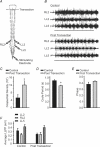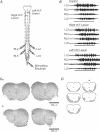Brainstem modulation of locomotion in the neonatal mouse spinal cord
- PMID: 18372309
- PMCID: PMC2464340
- DOI: 10.1113/jphysiol.2007.148320
Brainstem modulation of locomotion in the neonatal mouse spinal cord
Abstract
During development, descending projections to the spinal cord are immature. Available data suggest that even though these projections are not fully formed, they contribute to activation of spinal circuitry and promote development of network function. Here we examine the modulation of sacrocaudal afferent-evoked locomotor activity by descending pathways. We first examined the effects of brainstem transection on the afferent evoked locomotor-like rhythm using an isolated brainstem-spinal cord preparation of the mouse. Transection increased the frequency and stability of the locomotor-like rhythm while the phase remained unchanged. We then made histologically verified lesions of the ventrolateral funiculus and observed similar effects on the stability and frequency of the locomotor rhythm. We next tested whether these effects were due to downstream effects of the transection. A split-bath was constructed between the brainstem and spinal cord. Neural activity was suppressed in the brainstem compartment using cooled high sucrose solutions. This manipulation led to a reversible change in frequency and stability that mirrored our findings using lesion approaches. Our findings suggest that spontaneous brainstem activity contributes to the ongoing modulation of afferent-evoked locomotor patterns during early postnatal development. Our work suggests that some of the essential circuits necessary to modulate and control locomotion are at least partly functional before the onset of weight-bearing locomotion.
Figures





References
-
- Atsuta Y, Garcia-Rill E, Skinner RD. Characteristics of electrically induced locomotion in rat in vitro brain stem-spinal cord preparation. J Neurophysiol. 1990;64:727–735. - PubMed
-
- Blivis D, Mentis GZ, O'Donovan MJ, Lev-Tov A. Differential effects of opioids on sacrocaudal afferent pathways and central pattern generators in the neonatal rat spinal cord. J Neurophysiol. 2007;97:2875–2886. - PubMed
-
- Cowley KC, Schmidt BJ. A comparison of motor patterns induced by N-methyl-D-aspartate, acetylcholine and serotonin in the in vitro neonatal rat spinal cord. Neurosci Lett. 1994;171:147–150. - PubMed
Publication types
MeSH terms
LinkOut - more resources
Full Text Sources

